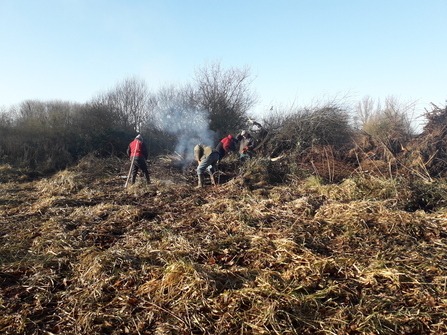Carlton Marshes is lying in wait for habitat creation works to start on the new land this spring. New pools dug to provide material for river wall improvements on Peto's Marsh are already bringing in the birds. Goosander, Shoveler, Teal, Wigeon and Cormorant are just some of the birds already using these pools. Cattle Egrets continue to be seen regularly at Carlton Marshes, coming into roost along with Little Egrets and Grey Herons. Stand on the river wall looking out over Whitecast Marsh at dawn or dusk to see these birds. For the best chance to see Short-eared owls head to Oulton Marshes where they are often seen hunting by day. Looking out over the newly purchased Peto's Marsh will also give you a great chance of spotting Short-eared owls, as well as a huge number of Chinese water deer. Otters are being seen regularly again this winter, at Carlton and Oulton Marshes in the Oulton Dyke and River Waveney, as well as on the reserve along the river walls. A family of Otters, the mother with two young, has been seen regularly at Carlton Marshes in recent weeks. Head to the end of the main track to the large soak dike and river for the best chance to see this playful, photogenic family.
Otters, wetland bird counts, water vole surveys...
Carlton Marshes by John Lord
Throughout the winter so far volunteers having been heading out at Carlton, Oulton and Castle Marshes on cold winter mornings to complete wetland bird surveys. The Wetland Bird Survey is a UK wide synchronised monthly count, which helps us to understand trends in wetland bird populations and assess the importance of different reserves. In the Waveney valley volunteers get good counts of birds such as Lapwing, Wigeon, Teal, Mute Swan, Snipe and Pink-footed Geese. As many as 2,000 Pink-footed geese are regularly seen at Oulton Marshes, which is an impressive sight when they decide to move off. Pink-footed geese that breed in Greenland and Iceland come to the UK to winter on coastal marshes and farmland. 85% of the global population of Pink-footed geese winter in the UK, making monitoring their population and providing suitable habitat for them even more important.

Burning scrub is another big part of the winter work for reserve volunteers across Suffolk. In the picture above at Oulton Marshes, alder scrub which has spread across the marsh has been pulled out by a digger and left in huge piles ready to be burnt by volunteers. Scrub, largely young willow and alder, is removed from wetland habitats to keep them open for the birds and plants that depend on them. It is a tiring job for volunteers, but it is great to warm up next to a huge fire when the sleet is being blown sideways across the marsh. Despite the weather, burning scrub seems to be popular task with an impressive 16 volunteers turning up to help last week!
Starting this month volunteers have also been helping survey the new land for signs of Water Vole. Volunteers at Carlton Marshes put out rafts along the dykes and then count the Water Vole droppings that appear on them. You can distinguish Water Vole droppings from other small mammals by their shape, size and colour, which is much easier than trying to find these shy mammals. Water Voles are a protected species because of the huge declines in their population nationally, this survey work ensures the safety of local Water Voles whilst carrying out habitat improvement works on the new land.
John Ferguson
Meet the volunteers!
Its hard to find a picture of Gavin, the one on the left here, as he is usually behind the camera, known locally for his brilliant wildlife photography. He's known by Suffolk Wildlife Trust staff as being willing and able to help with any task going. He took the brilliant pictures of the local Carlton Marshes Otter family shown above this January. Gavin told me about why he started volunteering for Suffolk Wildlife Trust. "I was born and raised around the local area and marshes and at an early age my late father instilled in me an appreciation for the landscape and everything within it. As I’ve grown older and seen the marsh taken into agriculture and the wetland habitats lost, I began to realise that most of the places I used to play in and wonder at were disappearing. Carlton Marshes was one of the last remaining areas I could see wildlife such as Barn Owls and Water Voles and I found myself spending more and more time there. I approached Matt Gooch about volunteering 6 years ago and I’ve found myself getting involved with tasks from surveying to conservation work parties. For the last 3 years or so I’ve been a volunteer warden, which I find really rewarding. I find my time spent volunteering to be a great way to de-stress and my anticipation of what I might see there never wanes. Being involved in the exciting project to restore the wetland habitat here and encourage wildlife back is incredibly satisfying, especially knowing I'm helping to leave somewhere my daughter can enjoy as she grows up."
Contact:
Ellen Shailes at ellen.shailes@suffolkwildlifetrust.org for more information about volunteering across the Suffolk Broads reserves or
Barry Bradnum at waveneyvalleygroup.swt@gmail.com for more information about the Waveney Valley Wildlife Group
Current volunteering roles:
Conservation work party volunteer - Gunton Warren nature reserve
Walking Warden - Gunton Warren nature reserve
Bird surveyor - Carlton Marshes nature reserve
Learning volunteer - Carlton Marshes nature reserve and across Lowestoft

Thanks to the generosity of our supporters and a £4 million grant from the National Lottery Heritage Fund, our vision to buy and restore 384 acres of land for wildlife in the Broads National Park is taking flight.



